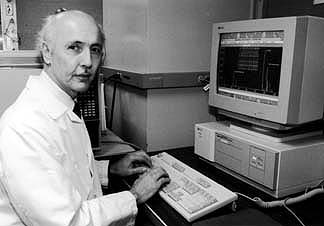Dr. Edward Cone, chief of the Chemistry and Drug Metabolism Section in the Clinical Pharmacology Branch of NIDA's Division of Intramural Research, has been honored for his achievements during a 23-year career in drug abuse research. Dr. Cone was named 1996 Career Scientist of the Year by the Scientists' Professional Advisory Committee of the U.S. Public Health Service. He was cited for his "pioneering research on the detection of psychoactive drugs in humans and for the broad implication of discoveries to improve drug abuse prevention and treatment."
 The Scientists' Professional Advisory Committee of the U.S. Public Health Service named Dr. Edward Cone its first Career Scientist of the Year for his work in detecting psychoactive drugs in humans. Here he examines hair analyses for cocaine.
The Scientists' Professional Advisory Committee of the U.S. Public Health Service named Dr. Edward Cone its first Career Scientist of the Year for his work in detecting psychoactive drugs in humans. Here he examines hair analyses for cocaine.Dr. Cone is the first recipient of the award, which was presented by acting Surgeon General Dr. Audrey Manley at a meeting of the Public Health Service Com-missioned Officers Association in Tulsa, Oklahoma, in May. The award recognizes scientists who are commissioned officers and have distinguished themselves in both their scientific and professional careers.
"This recognition of Dr. Cone's work is well deserved. In his 20 plus years with NIDA, he has made an enormous contribution both to the Institute's drug abuse research portfolio and to the field at large," said NIDA Director Dr. Alan I. Leshner.
Dr. Cone's recent work has included studies of the effects of passive exposure to drugs and research on sweat, saliva, and hair testing to detect drug use. He has shown that significant amounts of drugs can be absorbed from passive exposure. He also has found that sweat, collected on patches worn on the skin, serves as a sensitive indicator of cocaine and heroin abuse (see Sweat Testing May Prove Useful in Drug-Use Surveillance," NIDA NOTES, September/October 1995). Currently, Dr. Cone is studying how drug exposures that yield specific levels of drugs in blood, saliva, sweat, urine, hair, and skin relate to behavior and performance.
